

Compact Muon Solenoid
LHC, CERN
| CMS-SUS-16-042 ; CERN-EP-2017-201 | ||
| Search for supersymmetry in events with one lepton and multiple jets exploiting the angular correlation between the lepton and the missing transverse momentum in proton-proton collisions at $\sqrt{s} = $ 13 TeV | ||
| CMS Collaboration | ||
| 28 September 2017 | ||
| Phys. Lett. B 780 (2018) 384 | ||
| Abstract: Results are presented from a search for supersymmetry in events with a single electron or muon and hadronic jets. The data correspond to a sample of proton-proton collisions at $\sqrt{s} = $ 13 TeV with an integrated luminosity of 35.9 fb$^{-1}$, recorded in 2016 by the CMS experiment. A number of exclusive search regions are defined according to the number of jets, the number of b-tagged jets, the scalar sum of the transverse momenta of the jets, and the scalar sum of the missing transverse momentum and the transverse momentum of the lepton. Standard model background events are reduced significantly by requiring a large azimuthal angle between the direction of the lepton and of the reconstructed W boson, computed under the hypothesis that all of the missing transverse momentum in the event arises from a neutrino produced in the leptonic decay of the W boson. The numbers of observed events are consistent with the expectations from standard model processes, and the results are used to set lower limits on supersymmetric particle masses in the context of two simplified models of gluino pair production. In the first model, where each gluino decays to a top quark-antiquark pair and a neutralino, gluino masses up to 1.8 TeV are excluded at the 95% CL. The second model considers a three-body decay to a light quark-antiquark pair and a chargino, which subsequently decays to a W boson and a neutralino. In this model, gluinos are excluded up to 1.9 TeV. | ||
| Links: e-print arXiv:1709.09814 [hep-ex] (PDF) ; CDS record ; inSPIRE record ; CADI line (restricted) ; | ||
| Figures & Tables | Summary | Additional Figures & Tables | References | CMS Publications |
|---|
|
Additional information on efficiencies needed for reinterpretation of these results are available here. Additional technical material for CMS speakers can be found here |
| Figures | |

png pdf |
Figure 1:
Diagrams showing the simplified models (left) T1tttt and (right) T5qqqqWW. |

png pdf |
Figure 1-a:
Diagram showing the T1tttt simplified model. |
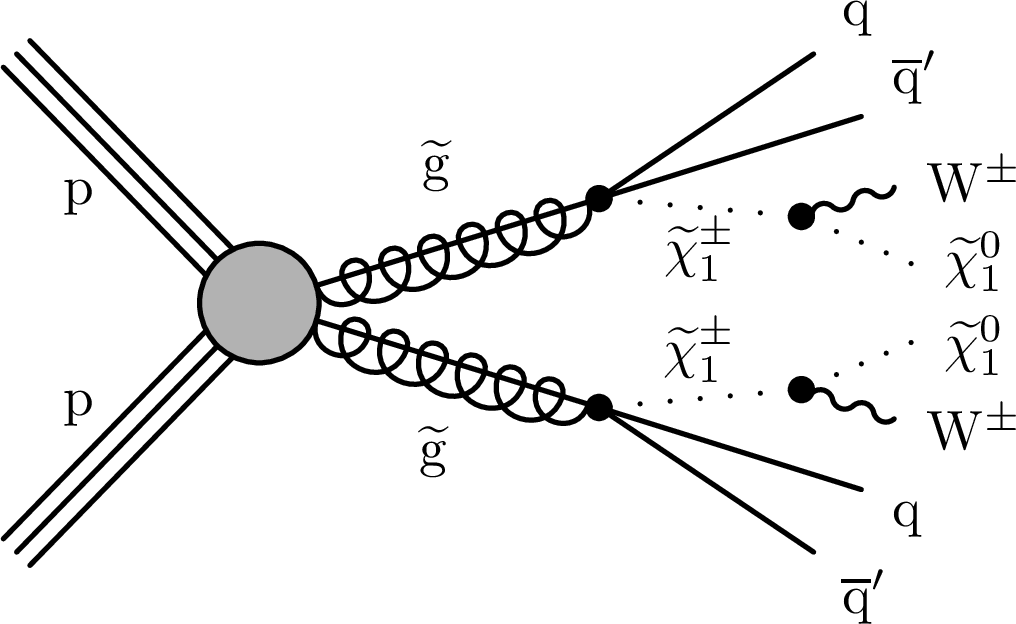
png pdf |
Figure 1-b:
Diagram showing the T5qqqqWW simplified model. |
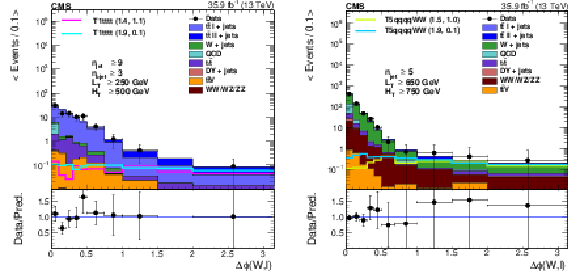
png pdf |
Figure 2:
Comparison of the $ {\Delta \phi} $ distribution for (left) the multi-b and (right) the 0-b analysis for two of the search bins given in Table xxxxx. The simulated background events are stacked on top of each other and several signal points are overlaid for illustration. The wider bins are normalized to a bin width of 0.1. The ratio of data to simulation is given in the lower panels. |
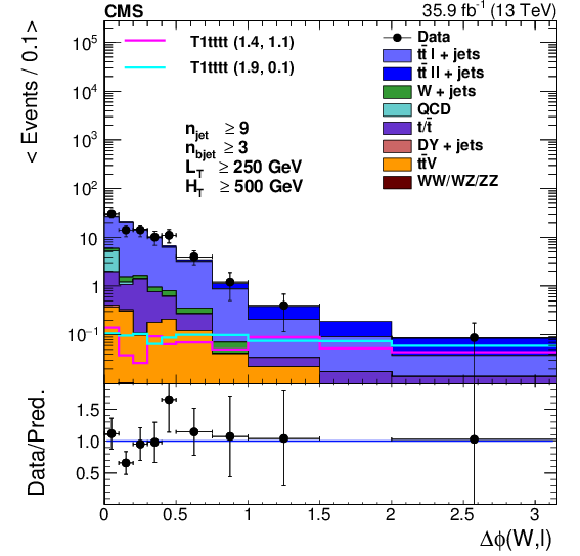
png pdf |
Figure 2-a:
Comparison of the $ {\Delta \phi} $ distribution for the multi-b analysis for two of the search bins given in Table xxxxx. The simulated background events are stacked on top of each other and several signal points are overlaid for illustration. The wider bins are normalized to a bin width of 0.1. The ratio of data to simulation is given in the lower panels. |
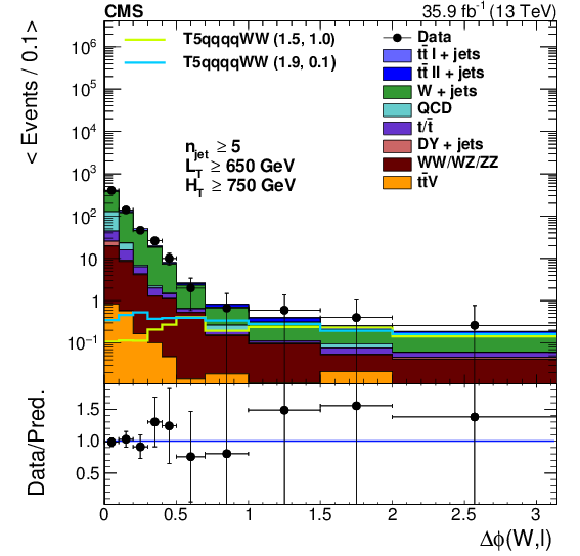
png pdf |
Figure 2-b:
Comparison of the $ {\Delta \phi} $ distribution for the 0-b analysis for two of the search bins given in Table xxxxx. The simulated background events are stacked on top of each other and several signal points are overlaid for illustration. The wider bins are normalized to a bin width of 0.1. The ratio of data to simulation is given in the lower panels. |
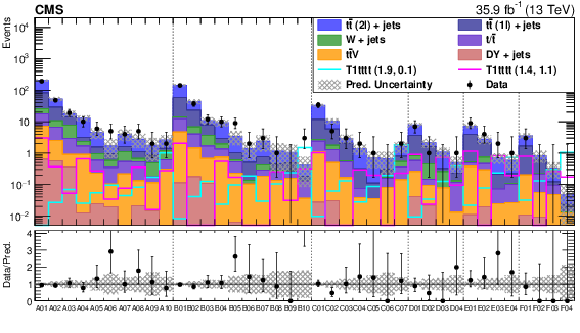
png pdf |
Figure 3:
Multi-b search: comparison of the numbers of events observed in the data and the numbers expected from the estimated SM backgrounds in the 39 search bins defined in the text, with details given in Table yyyyy. Upper panel: the data are represented by black points with error bars, while the total SM background expected is shown as a hatched region that represents the uncertainty. For illustration, the relative fraction of the different SM background contributions determined in simulation is shown by the stacked, colored histograms, normalized so that their sum is equal to the background estimated using data control regions, as described in the text. The expected event yields for two T1tttt SUSY benchmark models are represented by the open histograms. Lower panel: the ratio of the number of events observed in data to the number of events expected from the SM background in each search bin. The error bars on the data points indicate the statistical uncertainty in the ratio, while the gray hatched region indicates the uncertainty on this ratio from the uncertainty in the background estimate. |

png pdf |
Figure 4:
0-b search: comparison of the numbers of events observed in the data and the numbers expected from the estimated SM backgrounds in the 28 search bins defined in the text, with details given in Table zzzzz. Upper panel: the data are represented by black points with error bars, while the total SM background expected is shown as a hatched region that represents the uncertainty. The filled, stacked histograms represent the predictions for ${{\mathrm{t} {}\mathrm{\bar{t}}}}$+jets, W+jets events, and the remaining backgrounds. The expected yields from two T5qqqqWW SUSY benchmark models are represented as solid lines. Lower panel: the ratio of the number of events observed in data to the number of events expected from the SM background in each search bin. The error bars on the data points indicate the statistical uncertainty in the ratio, while the gray hatched region indicates the uncertainty on this ratio from the uncertainty in the background estimate. |

png pdf |
Figure 5:
Cross section limits at a 95% CL for the (left) T1tttt and (right) T5qqqqWW models, as a function of the gluino and LSP masses. In T5qqqqWW, the pair-produced gluinos decay to first- or second-generation quark-antiquark pairs (${\mathrm{q} \mathrm{\bar{q}}}$) and a chargino ($\tilde{\chi}^{\pm}_1$) with its mass taken to be $m_{\tilde{\chi}^{\pm}_1}=0.5(m_{{\mathrm{\widetilde{g}}}}+m_{\tilde{\chi}^0_1})$. The solid black (dashed red) lines correspond to the observed (expected) mass limits, with the thicker lines representing the central values and the thinner lines representing the limits of 68% uncertainty bands related to the theoretical (experimental) uncertainties. |

png pdf root |
Figure 5-a:
Cross section limits at a 95% CL for the T1tttt model, as a function of the gluino and LSP masses. The solid black (dashed red) lines correspond to the observed (expected) mass limits, with the thicker lines representing the central values and the thinner lines representing the limits of 68% uncertainty bands related to the theoretical (experimental) uncertainties. |
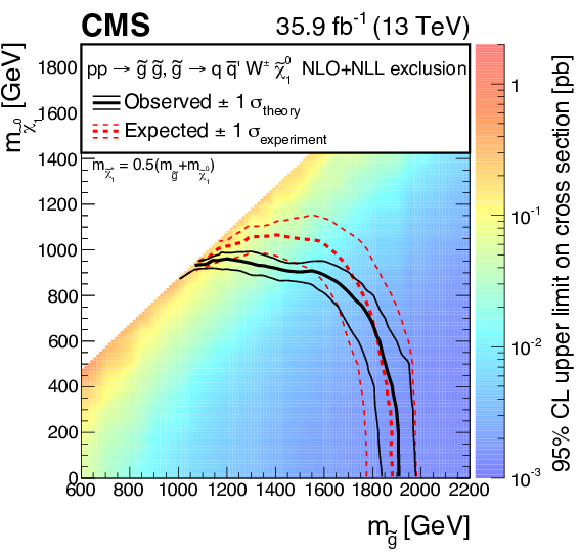
png pdf root |
Figure 5-b:
Cross section limits at a 95% CL for the T5qqqqWW model, as a function of the gluino and LSP masses. The pair-produced gluinos decay to first- or second-generation quark-antiquark pairs (${\mathrm{q} \mathrm{\bar{q}}}$) and a chargino ($\tilde{\chi}^{\pm}_1$) with its mass taken to be $m_{\tilde{\chi}^{\pm}_1}=0.5(m_{{\mathrm{\widetilde{g}}}}+m_{\tilde{\chi}^0_1})$. The solid black (dashed red) lines correspond to the observed (expected) mass limits, with the thicker lines representing the central values and the thinner lines representing the limits of 68% uncertainty bands related to the theoretical (experimental) uncertainties. |
| Tables | |

png pdf |
Table 1:
Overview of the definitions of the various regions and samples employed in the analysis. For the QCD fit the electron (e) sample is used, while for the determination (det.) of $ {R_{\mathrm {CS}}} (\mathrm{W^{\pm}})$ the muon ($\mu $) sample is used. Regions corresponding to blank cells are not used in the analysis. |

png pdf |
Table 2:
Summary of systematic uncertainties in the total background estimates for the multi-b and for the 0-b analyses. |
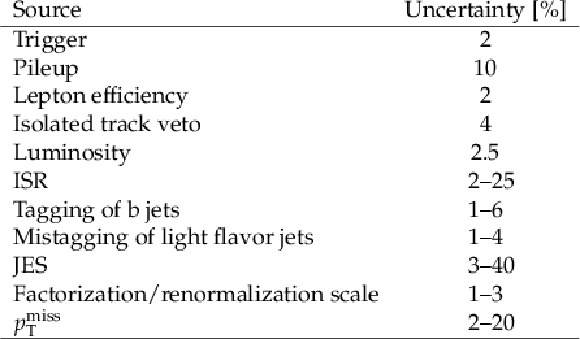
png pdf |
Table 3:
Summary of the systematic uncertainties and their average effect on the yields for the benchmark points defined in the text. The values, which are quite similar for the multi-b and the 0-b analyses, are usually larger for compressed scenarios, where the mass difference between the gluino and the lightest neutralino is small. |
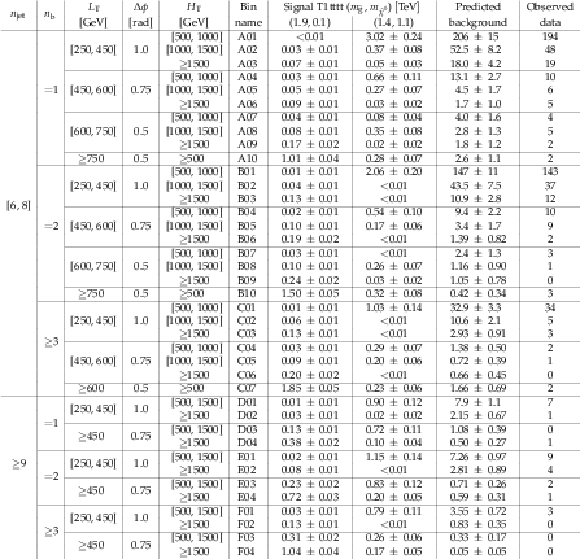
png pdf |
Table 4:
Definition of search bins and naming convention in the multi-b search. Also given are the $ {\Delta \phi} $ values that are used to define the CRs and the SRs, the numbers of expected background events with combined statistical and systematic uncertainties, the observed numbers of events, and the expected numbers of signal events in the multi-b search bins. |
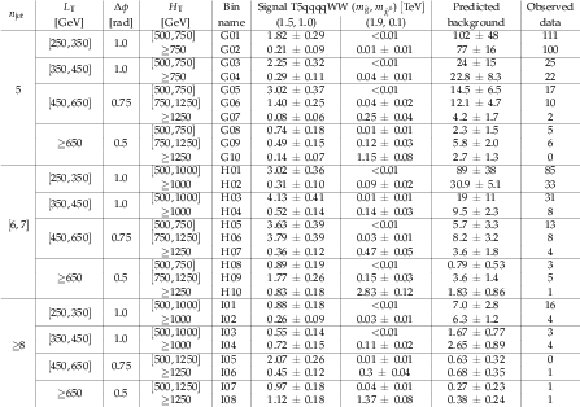
png pdf |
Table 5:
Definition of search bins and naming convention in the 0-b search. Also given are the $ {\Delta \phi} $ values that are used to define the CRs and the SRs, the numbers of expected background events with combined statistical and systematic uncertainties, the observed numbers of events, and the expected numbers of signal events in the 0-b search bins. |

png pdf |
Table 6:
Numbers of expected background events with combined statistical and systematic uncertainty and the observed numbers of events in aggregated search bins. The expected number of signal events for the two corresponding benchmark signals for the multi-b and 0-b analyses, respectively, are given as well. |
| Summary |
|
A search for supersymmetry has been performed using a 35.9 fb$^{-1}$ sample of proton-proton collisions at $\sqrt{s} = $ 13 TeV, recorded by the CMS experiment in 2016. Several exclusive search bins are defined that differ in the number of jets, the number of b-tagged jets, the scalar sum of all jet transverse momenta as well as the scalar sum of the missing transverse momentum and the transverse momentum of the lepton. The main background processes, which arise from W+jets and ${\mathrm{t\bar{t}}}$+jets in a final state with exactly one lepton and multiple jets, is reduced significantly by requiring a large azimuthal angle between the direction of the lepton and of the reconstructed W boson, computed under the hypothesis that all of the missing transverse momentum in the event arises from a neutrino produced in the leptonic decay of the W boson. The event yields observed in data are in agreement with the standard model background, which is estimated using control regions in data and corrections based on simulation. The lack of any significant excess of events is interpreted in terms of limits on the parameters of two simplified models that describe gluino pair production. For the T1tttt simplified model, in which each gluino decays to a $\mathrm{t\bar{t}}$ pair and the lightest neutralino, gluino masses up to 1.8 TeV are excluded for neutralino masses below 800 GeV. Neutralino masses below 1.1 TeV are excluded for a gluino mass up to 1.7 TeV. This result extends the exclusion limit from the previous analysis [13] on gluino masses by about 250 GeV. The second simplified model, T5qqqqWW, also describes gluino pair production, but with decays to first- or second-generation quarks and a chargino, which decays to a W boson and the lightest neutralino. The chargino mass in this decay channel is assumed to be $m_{\tilde{\chi}^{\pm}_1}=0.5(m_{{\mathrm{\widetilde{g}}}}+m_{\tilde{\chi}^0_1})$. Gluino masses below 1.9 TeV are excluded for neutralino masses below 300 GeV. This corresponds to an improvement of about 500 GeV over the previous result [13]. For a gluino mass of 1.2 TeV, neutralinos with masses up to 950 GeV are excluded. |
| Additional Figures | |

png pdf root |
Additional Figure 1:
Observed significance in the multi-b search regions for T1tttt. |
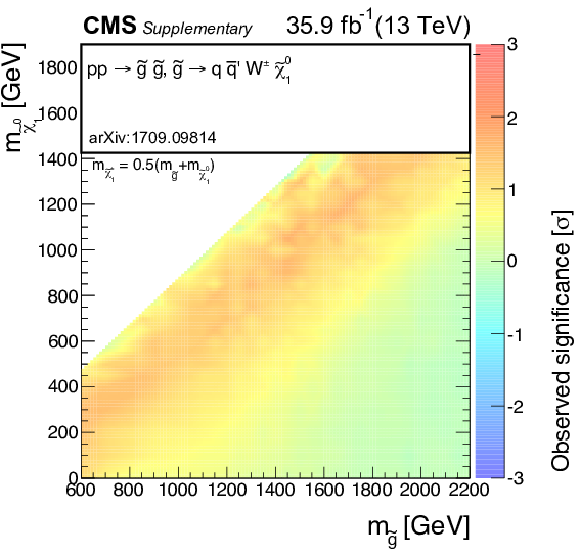
png pdf root |
Additional Figure 2:
Observed significance in the 0-b search regions for T5qqqqWW. |
| Additional Tables | |
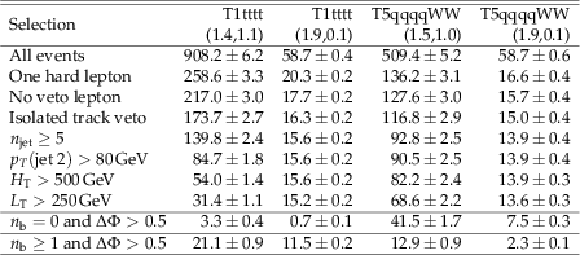
png pdf |
Additional Table 1:
Expected event yields for the four SUSY signal benchmark points defined in the text, for a total integrated luminosity of 36 fb$^{-1}$. The baseline selection corresponds to all requirements up to and including the requirement on ${L_\mathrm {T}}$. The last two lines are exclusive for the zero-b and the multi-b selection respectively. The numbers of events are corrected with scale factors to account for differences between the simulation and data for the lepton identification and isolation efficiencies, the trigger efficiency and the b-tagging efficiency. |
| References | ||||
| 1 | P. Ramond | Dual theory for free fermions | PRD 3 (1971) 2415 | |
| 2 | \relax Yu. A. Golfand and E. P. Likhtman | Extension of the algebra of Poincar$ \'e $ group generators and violation of P invariance | JEPTL 13 (1971)323 | |
| 3 | A. Neveu and J. H. Schwarz | Factorizable dual model of pions | NPB 31 (1971) 86 | |
| 4 | D. V. Volkov and V. P. Akulov | Possible universal neutrino interaction | JEPTL 16 (1972)438 | |
| 5 | J. Wess and B. Zumino | A Lagrangian model invariant under supergauge transformations | PLB 49 (1974) 52 | |
| 6 | J. Wess and B. Zumino | Supergauge transformations in four dimensions | NPB 70 (1974) 39 | |
| 7 | P. Fayet | Supergauge invariant extension of the Higgs mechanism and a model for the electron and its neutrino | NPB 90 (1975) 104 | |
| 8 | H. P. Nilles | Supersymmetry, supergravity and particle physics | Phys. Rep. 110 (1984) 1 | |
| 9 | R. Barbieri and G. F. Giudice | Upper bounds on supersymmetric particle masses | NPB 306 (1988) 63 | |
| 10 | G. R. Farrar and P. Fayet | Phenomenology of the production, decay, and detection of new hadronic states associated with supersymmetry | PLB 76 (1978) 575 | |
| 11 | C. Boehm, A. Djouadi, and M. Drees | Light scalar top quarks and supersymmetric dark matter | PRD 62 (2000) 035012 | hep-ph/9911496 |
| 12 | C. Balazs, M. Carena, and C. E. M. Wagner | Dark matter, light stops and electroweak baryogenesis | PRD 70 (2004) 015007 | hep-ph/0403224 |
| 13 | CMS Collaboration | Search for supersymmetry in events with one lepton and multiple jets in proton-proton collisions at $ \sqrt{s} = $ 13 TeV | PRD 95 (2017) 012011 | CMS-SUS-15-006 1609.09386 |
| 14 | CMS Collaboration | Search for supersymmetry in pp collisions at $ \sqrt{s} = $ 7 TeV in events with a single lepton, jets, and missing transverse momentum | EPJC 73 (2013) 2404 | CMS-SUS-12-010 1212.6428 |
| 15 | CMS Collaboration | Search for supersymmetry in final states with a single lepton, b-quark jets, and missing transverse energy in proton-proton collisions at $ \sqrt{s} = $ 7 TeV | PRD 87 (2013) 052006 | CMS-SUS-11-028 1211.3143 |
| 16 | ATLAS Collaboration | Further search for supersymmetry at $ \sqrt{s} = $ 7 TeV in final states with jets, missing transverse momentum and isolated leptons with the ATLAS detector | PRD 86 (2012) 092002 | 1208.4688 |
| 17 | CMS Collaboration | Search for supersymmetry in pp collisions at $ \sqrt{s} = $ 8 TeV in events with a single lepton, large jet multiplicity, and multiple b jets | PLB 733 (2014) 328 | CMS-SUS-13-007 1311.4937 |
| 18 | ATLAS Collaboration | Search for squarks and gluinos in events with isolated leptons, jets and missing transverse momentum at $ \sqrt{s} = $ 8 TeV with the ATLAS detector | JHEP 04 (2015) 116 | 1501.03555 |
| 19 | ATLAS Collaboration | Search for strong production of supersymmetric particles in final states with missing transverse momentum and at least three b-jets at $ \sqrt{s} = $ 8 TeV proton-proton collisions with the ATLAS detector | JHEP 10 (2014) 024 | 1407.0600 |
| 20 | CMS Collaboration | Search for supersymmetry in pp collisions at $ \sqrt{s} = $ 13 TeV in the single-lepton final state using the sum of masses of large-radius jets | JHEP 08 (2016) 122 | CMS-SUS-15-007 1605.04608 |
| 21 | ATLAS Collaboration | Search for gluinos in events with an isolated lepton, jets and missing transverse momentum at $ \sqrt{s} = $ 13 TeV with the ATLAS detector | EPJC 76 (2016) 565 | 1605.04285 |
| 22 | ATLAS Collaboration | Search for pair production of gluinos decaying via stop and sbottom in events with $ b $-jets and large missing transverse momentum in $ pp $ collisions at $ \sqrt{s} = $ 13 TeV with the ATLAS detector | PRD 94 (2016) 032003 | 1605.09318 |
| 23 | N. Arkani-Hamed et al. | MARMOSET: The path from LHC data to the new standard model via on-shell effective theories | hep-ph/0703088 | |
| 24 | J. Alwall, P. C. Schuster, and N. Toro | Simplified models for a first characterization of new physics at the LHC | PRD 79 (2009) 075020 | 0810.3921 |
| 25 | J. Alwall, M.-P. Le, M. Lisanti, and J. G. Wacker | Model-independent jets plus missing energy searches | PRD 79 (2009) 015005 | 0809.3264 |
| 26 | D. Alves et al. | Simplified models for LHC new physics searches | JPG 39 (2012) 105005 | 1105.2838 |
| 27 | CMS Collaboration | The CMS experiment at the CERN LHC | JINST 3 (2008) S08004 | CMS-00-001 |
| 28 | CMS Collaboration | Particle-flow reconstruction and global event description with the CMS detector | Submitted to JINST | CMS-PRF-14-001 1706.04965 |
| 29 | M. Cacciari and G. P. Salam | Pileup subtraction using jet areas | PLB 659 (2008) 119 | 0707.1378 |
| 30 | M. Cacciari, G. P. Salam, and G. Soyez | The anti-$ k_t $ jet clustering algorithm | JHEP 04 (2008) 063 | 0802.1189 |
| 31 | CMS Collaboration | Determination of jet energy calibration and transverse momentum resolution in CMS | JINST 6 (2011) P11002 | CMS-JME-10-011 1107.4277 |
| 32 | M. Cacciari, G. P. Salam, and G. Soyez | Fastjet user manual | EPJC 72 (2012) 1896 | 1111.6097 |
| 33 | CMS Collaboration | Jet energy scale and resolution in the CMS experiment in pp collisions at 8 TeV | JINST 12 (2017) P02014 | CMS-JME-13-004 1607.03663 |
| 34 | CMS Collaboration | Identification of b-quark jets with the CMS experiment | JINST 8 (2013) P04013 | CMS-BTV-12-001 1211.4462 |
| 35 | CMS Collaboration | Identification of b quark jets at the cms experiment in the lhc run 2 | CMS-PAS-BTV-15-001 | CMS-PAS-BTV-15-001 |
| 36 | J. Alwall et al. | The automated computation of tree-level and next-to-leading order differential cross sections, and their matching to parton shower simulations | JHEP 07 (2014) 079 | 1405.0301 |
| 37 | P. Nason | A new method for combining NLO QCD with shower Monte Carlo algorithms | JHEP 11 (2004) 040 | hep-ph/0409146 |
| 38 | S. Frixione, P. Nason, and C. Oleari | Matching NLO QCD computations with parton shower simulations: the POWHEG method | JHEP 11 (2007) 070 | 0709.2092 |
| 39 | S. Alioli, P. Nason, C. Oleari, and E. Re | A general framework for implementing NLO calculations in shower Monte Carlo programs: the POWHEG BOX | JHEP 06 (2010) 043 | 1002.2581 |
| 40 | S. Alioli, P. Nason, C. Oleari, and E. Re | NLO single-top production matched with shower in POWHEG: $ s $- and $ t $-channel contributions | JHEP 09 (2009) 111 | 0907.4076 |
| 41 | E. Re | Single-top $ Wt $-channel production matched with parton showers using the POWHEG method | EPJC 71 (2011) 1547 | 1009.2450 |
| 42 | T. Melia, P. Nason, R. Rontsch, and G. Zanderighi | W$ ^+ $W$ ^- $, WZ and ZZ production in the POWHEG BOX | JHEP 11 (2011) 078 | 1107.5051 |
| 43 | M. Beneke, P. Falgari, S. Klein, and C. Schwinn | Hadronic top-quark pair production with NNLL threshold resummation | NPB 855 (2012) 695 | 1109.1536 |
| 44 | M. Cacciari et al. | Top-pair production at hadron colliders with next-to-next-to-leading logarithmic soft-gluon resummation | PLB 710 (2012) 612 | 1111.5869 |
| 45 | P. Barnreuther, M. Czakon, and A. Mitov | Percent level precision physics at the tevatron: First genuine NNLO QCD corrections to $ q \bar{q} \to t \bar{t} + X $ | PRL 109 (2012) 132001 | 1204.5201 |
| 46 | M. Czakon and A. Mitov | NNLO corrections to top-pair production at hadron colliders: the all-fermionic scattering channels | JHEP 12 (2012) 054 | 1207.0236 |
| 47 | M. Czakon and A. Mitov | NNLO corrections to top pair production at hadron colliders: the quark-gluon reaction | JHEP 01 (2013) 080 | 1210.6832 |
| 48 | M. Czakon, P. Fiedler, and A. Mitov | Total top-quark pair-production cross section at hadron colliders through $ \mathcal{O}(\alpha_S^4) $ | PRL 110 (2013) 252004 | 1303.6254 |
| 49 | R. Gavin, Y. Li, F. Petriello, and S. Quackenbush | W physics at the LHC with FEWZ 2.1 | CPC 184 (2013) 208 | 1201.5896 |
| 50 | R. Gavin, Y. Li, F. Petriello, and S. Quackenbush | FEWZ 2.0: A code for hadronic Z production at next-to-next-to-leading order | CPC 182 (2011) 2388 | 1011.3540 |
| 51 | NNPDF Collaboration | Parton distributions for the LHC Run II | JHEP 04 (2015) 040 | 1410.8849 |
| 52 | T. Sjostrand et al. | An introduction to PYTHIA 8.2 | CPC 191 (2015) 159 | 1410.3012 |
| 53 | W. Beenakker, R. Hopker, M. Spira, and P. M. Zerwas | Squark and gluino production at hadron colliders | NPB 492 (1997) 51 | hep-ph/9610490 |
| 54 | A. Kulesza and L. Motyka | Threshold resummation for squark-antisquark and gluino-pair production at the LHC | PRL 102 (2009) 111802 | 0807.2405 |
| 55 | A. Kulesza and L. Motyka | Soft gluon resummation for the production of gluino-gluino and squark-antisquark pairs at the LHC | PRD 80 (2009) 095004 | 0905.4749 |
| 56 | W. Beenakker et al. | Soft-gluon resummation for squark and gluino hadroproduction | JHEP 12 (2009) 041 | 0909.4418 |
| 57 | W. Beenakker et al. | Squark and gluino hadroproduction | Int. J. Mod. Phys. A 26 (2011) 2637 | 1105.1110 |
| 58 | CMS Collaboration | Event generator tunes obtained from underlying event and multiparton scattering measurements | EPJC 76 (2016) 155 | CMS-GEN-14-001 1512.00815 |
| 59 | GEANT4 Collaboration | GEANT4---a simulation toolkit | NIMA 506 (2003) 250 | |
| 60 | CMS Collaboration | The fast simulation of the CMS detector at LHC | J. Phys. Conf. Ser. 331 (2011) 032049 | |
| 61 | C. G. Lester and D. J. Summers | Measuring masses of semi-invisibly decaying particle pairs produced at hadron colliders | PLB 463 (1999) 5 | |
| 62 | CMS Collaboration | Performance of electron reconstruction and selection with the CMS detector in proton-proton collisions at $ \sqrt{s} = $ 8 TeV | JINST 10 (2015) P06005 | CMS-EGM-13-001 1502.02701 |
| 63 | CMS Collaboration | Performance of CMS muon reconstruction in pp collision events at $ \sqrt{s} = $ 7 TeV | JINST 7 (2012) P10002 | CMS-MUO-10-004 1206.4071 |
| 64 | ATLAS Collaboration | Measurement of the inelastic proton-proton cross section at $ \sqrt{s} = $ 13 TeV with the ATLAS detector at the LHC | PRL 117 (2016) 182002 | 1606.02625 |
| 65 | CMS Collaboration | Measurement of the production cross section of a W boson in association with two b jets in pp collisions at $ \sqrt{s} = $ 8 TeV | EPJC 77 (2017) 92 | CMS-SMP-14-020 1608.07561 |
| 66 | Z. Bern et al. | Left-handed W bosons at the LHC | PRD 84 (2011) 034008 | 1103.5445 |
| 67 | CMS Collaboration | Angular coefficients of Z bosons produced in pp collisions at $ \sqrt{s} = $ 8 TeV and decaying to $ \mu^+ \mu^- $ as a function of transverse momentum and rapidity | PLB 750 (2015) 154 | CMS-SMP-13-010 1504.03512 |
| 68 | CMS Collaboration | Measurement of the polarization of W bosons with large transverse momenta in W+jets events at the LHC | PRL 107 (2011) 021802 | CMS-EWK-10-014 1104.3829 |
| 69 | ATLAS Collaboration | Measurement of the polarisation of $ W $ bosons produced with large transverse momentum in $ pp $ collisions at $ \sqrt{s} = $ 7 TeV with the ATLAS experiment | EPJC 72 (2012) 2001 | 1203.2165 |
| 70 | ATLAS Collaboration | Measurement of the $ W $ boson polarization in top quark decays with the ATLAS detector | JHEP 06 (2012) 088 | 1205.2484 |
| 71 | CMS Collaboration | Measurement of top quark polarisation in t-channel single top quark production | JHEP 04 (2016) 073 | CMS-TOP-13-001 1511.02138 |
| 72 | ATLAS Collaboration | Measurement of the $ W $ boson polarisation in $ t\bar{t} $ events from pp collisions at $ \sqrt{s} = $ 8 TeV in the lepton+jets channel with ATLAS | EPJC 77 (2017) 264 | 1612.02577 |
| 73 | A. Czarnecki, J. G. Korner, and J. H. Piclum | Helicity fractions of $ W $ bosons from top quark decays at NNLO in QCD | PRD 81 (2010) 111503 | 1005.2625 |
| 74 | CMS Collaboration | CMS luminosity measurement for the 2015 data taking period | CMS-PAS-LUM-15-001 | CMS-PAS-LUM-15-001 |
| 75 | CMS Collaboration | CMS luminosity measurements for the 2016 data taking period | CMS-PAS-LUM-17-001 | CMS-PAS-LUM-17-001 |
| 76 | G. Cowan, K. Cranmer, E. Gross, and O. Vitells | Asymptotic formulae for likelihood-based tests of new physics | EPJC 71 (2011) 1554 | 1007.1727 |
| 77 | T. Junk | Confidence level computation for combining searches with small statistics | NIMA 434 (1999) 435 | hep-ex/9902006 |
| 78 | A. L. Read | Presentation of search results: the $ \rm CL_s $ technique | JPG 28 (2002) 2693 | |

|
Compact Muon Solenoid LHC, CERN |

|

|

|

|

|

|